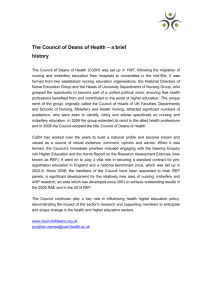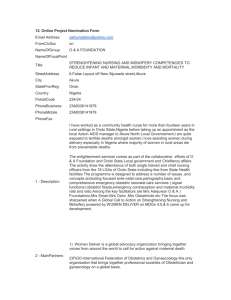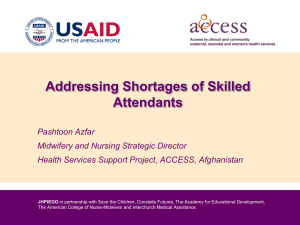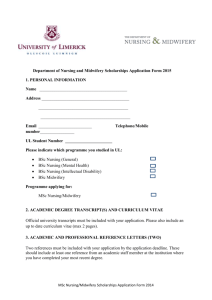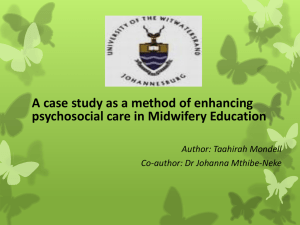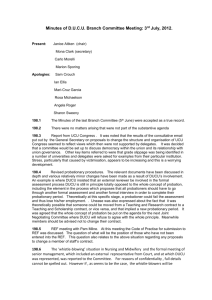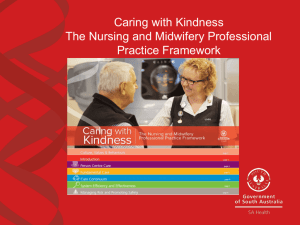PowerPoint slides
advertisement
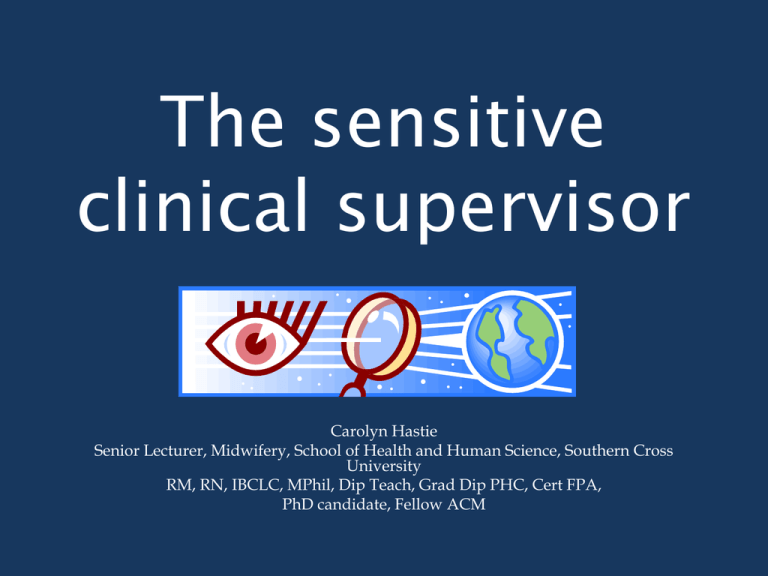
The sensitive clinical supervisor Carolyn Hastie Senior Lecturer, Midwifery, School of Health and Human Science, Southern Cross University RM, RN, IBCLC, MPhil, Dip Teach, Grad Dip PHC, Cert FPA, PhD candidate, Fellow ACM Psychophysiology & Neuroscience • • • • • • • Brain development Emotions Mirror neurons Neural networks Learning process Gut feelings SCARF model Emotions are the body’s currency Core emotional needs John Heron 1981 1. Love. 2. Understanding 3. Choice Love to love and be loved – to give and receive caring, affection, warmth, appreciation, support Understanding to understand and be understood – to have a grasp of what is going on Choice to choose and be chosen – to be able to take part in the decisions that affect our lives – to be chosen as someone special because of our own particular gifts or qualities. 4 Key Emotional and Social Competencies (of 21) The capacity to: • Recognise our own emotions and feelings • Manage ourselves effectively • Recognise others’ emotions and feelings • Interact with others effectively Dubin’s Model of Learning Trust An inner security based on an outer relationship “The shortest distance between two people is a smile” Victor Borge 1909 - 2000 SCARF A brain based model for collaborating with and influencing others S = Status C = Certainty A = Autonomy R = Relationships F = Fair References • • • • • • • • • • • • • • • • • • • • • Adolphs, R. (2001). The neurobiology of social cognition. Current Opinion in Neurobiology, 11(2), 231-239. Adolphs, R., Tranel, D., & Damasio, A. R. (1998). The human amygdala in social judgment. Nature, 393, 470–474. Bale, T. L. (2006). Stress sensitivity and the development of affective disorders. Hormones and Behavior 50(4), 529-533. Bar-On, R., & Parker, J. D. A. (Eds.). (2000). The Handbook of Emotional Intelligence: Theory Development, Assessment and Application at Home, School, and in the Workplace. San Francisco: Jossey-Bass Inc. Barker, P. (1999). Emotional competence in professional communication. Journal of Psychiatric and Mental Health Nursing, 6, 153-159. Benedetti, F., Lanotte, M., Lopiano, L., & Colloca, L. (2007). When words are painful: Unraveling the mechanisms of the nocebo effect NEUROSCIENCE 147(2), 260-271. Berto, R. (2005). Exposure to restorative environments helps restore attentional capacity. Journal of Environmental Psychology, 25(3), 249-259. Brown, P. (1991). The Hypnotic Brain (First ed.). New York: Yale University. Cacioppo, J. T., Tassinary, L. G., & Berntson, G. G. (2007). Handbook of psychophysiology (3rd Edition ed.). New York: Cambridge University Press. Csikszentmihalyi, M. (1990). Flow: The Psychology of Optimal Experience. New York: Harper and Row. De Martino, B., Kumaran, D., Seymour, B., & Dolan, R. J. (2006). Frames, Biases, and Rational Decision-Making in the Human Brain. Science, 313(5787), 684-687. Dias-Ferreira, E., Sousa, J. C., Melo, J., Morgado, P., Mesquita, A. R., Cerqueira, J. J., et al. (2009). Chronic Stress Causes Frontostriatal Reorganization and Affects Decision-Making Science 325(5940), 621-625. Dubin, P. (1962) Human Relations in Administration, London, Prentice Hall. Fahy, K., Foureur, M., & Hastie, C. (Eds.). (2008 ). Birth Territory and Midwifery Guardianship: Theory for Practice, Education and Research. Edinburgh: Elsevier Science. Frankl, V. E. (1946). Man's Search For Meaning. New York: Pocket Books. Gary, G. W., Evans, W., & Stecker, R. (2004). Motivational consequences of environmental stress. Journal of Environmental Psychology, 24(2), 143-165. Goleman, D. (1996). Emotional Intelligence (First ed.). London: Bloomsbury Publishing. Goleman, D. (2006). Social Intelligence: The New Science of Human Relationships. London: Hutchinson. Greene, D. J., Mooshagian, E., Kaplan, J. T., Zaidel, E., & Iacoboni, M. (2009). The neural correlates of social attention: automatic orienting to social and nonsocial cues. Psychological Research, 73(4), 499–511. Griffiths, L. (2003). Making connections: studies of the social organisation of health care. Sociology of Health and Illness, 5 (Silver Anniversary Issue), 155171. Heron, J. (1999). The Complete Facilitator's Handbook. London: Kogan Page. References (continued) • • • • • • • • • • • • • • • • • • • • • Hunter, B. (2001). Emotion work in midwifery: a review of current knowledge. Journal of Advanced Nursing Volume 34(4), 436-444. Imamizu, H., & Kawato, M. (2009). Brain mechanisms for predictive control by switching internal models: implications for higher-order cognitive functions. Psychological Research, 73(4), 527–544. LeDoux, J. (1998). The Emotional Brain (1998 ed.). London: Phoenix. Lipton, B. (2005). The Biology of Belief. Santa Rosa: Mountain of Love/Elite Books. Lyndon, A. (2008). Social and Environmental Conditions Creating Fluctuating Agency for Safety in Two Urban Academic Birth Centres. Journal of Obstetric, Gynaecologic & Neonatal Nursing, 37, 13-23. Pert, C. (1997). Molecules of Emotion: The Science behind Mind-Body Medicine. New York: Scribner. Rock, D. (2008) “SCARF: A brain based model for collaborating with and influencing others” Neuroleadership Journal, 1, p. 78-87. Rose, S. (2006). The 21st Century Brain: Explaining, mending and manipulating the mind (First ed.). London: Jonathon Cape. Rossi, E. L. (2002). The Psychobiology of Gene Expression (First ed.). London: WW Norton & Company. Saunders, A. (Writer), & A. Saunders (Director) (2009). Resilience: can it be built through design? [Radio]. In J. Ryan (Producer), By Design. Australia: Australian Broadcasting Commission. Schiller, D., Levy, I., Niv, Y., LeDoux, J. E., & Phelps, E. A. (2008). From Fear to Safety and Back: Reversal of Fear in the Human Brain. The Journal of Neuroscience, 28(45), 11517-11525. Schon, D. A. (1991). The Reflective Practitioner, How Professionals think in Action. Avebury: Ashgate Publishing. Scott, T., Mannion, R., Davies, H., & Marshall, M. (2003). Implementing culture change in health care: theory and practice. International Journal for Quality in Health Care, 15(2), 111-118. Sternberg, E. M., & Wilson, M. A. (2006). Neuroscience and Architecture: Seeking Common Ground. Cell, 127, 239-242. Strickland, D. (2000). Emotional Intelligence. Journal of Nurse Administration, 30(3). Sundin-Huard, D. (2001). Subject positions theory - its application to understanding collaboration (and confrontation) in critical care. Journal of Advanced Nursing, 34(3 %R doi:10.1046/j.1365-2648.2001.01766.x), 376-382. Taylor, M. (1996). An ex midwife’s Reflections on Supervision from a Psychotherapeutic Viewpoint. In M. Kirkham (Ed.), Supervision of Midwives. Cheshire: Books for Midwives Press. Taylor, B.J. (2011) Reflective Practice for Healthcare Professionals, (3rd Ed). Berkshire, Open University Press. Thompson, F. (2004). Midwives and Mothers: the Ethical Journey. London: Elsevier. Uvnas-Moberg, K. (2003). The Oxytocin Factor: Tapping the hormone of calm, love and healing. Cambridge: Da Capo. Whitehouse, D. (1991). Games of One-Upmanship and Sabotage. Nursing Management, 22(6), 46-50.

